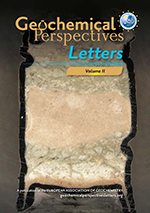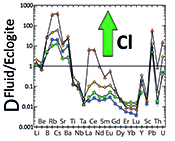 | Experimental evidence for fluid-induced melting in subduction zones Abstract: Although subduction zones are the main source of seismic and volcanic hazards on Earth, the causes of melting in volcanic arcs are still not fully understood. Recent models suggested that melting in the mantle wedge is not caused by hydrous fluids, but by sediment melts ascending from the subducted slab. A main argument for these models was that hydrous fluids are “too dilute” to produce the trace element enrichment observed in arc magmas. Here we demonstrate experimentally that even moderate salinities enhance the partitioning of trace elements such as the light rare earths, alkalis, alkaline earths, Pb, and U into the fluid by several orders of magnitude. Our data therefore show that saline hydrous fluids released from the basaltic part of the oceanic crust may produce the enrichment in LILE and light REE elements, and the negative Nb-Ta anomaly observed in typical arc magmas. |
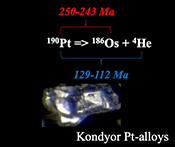 | 190Pt-186Os geochronometer reveals open system behaviour of 190Pt-4He isotope system Abstract: Platinum Group Minerals are typically dated using the 187Re-187Os and 190Pt-186Os isotope systems and more recently using the 190Pt-4He geochronometer. The 187Re-187Os and 190Pt-186Os compositions of Pt-alloys from the Kondyor Zoned Ultramafic Complex (ZUC) analysed here reveal overprinting for both geochronometers except in one alloy exhibiting the most unradiogenic 187Os/188Os and most radiogenic 186Os/188Os signatures. These signatures argue for an Early Triassic mineralisation, when silicate melts/fluids derived from the partial melting of an Archean mantle crystallised to form the Kondyor ZUC while the 190Pt-4He chronometer supports an Early Cretaceous mineralisation. We propose that Kondyor ZUC represents the root of an alkaline picritic volcano that constitutes the remnants of an Early Triassic island arc formed during the subduction of the Mongol-Okhotsk ocean seafloor under the Siberia craton. After the Early Cretaceous collision of Siberia with the Mongolia-North China continent, the exhumation of deep-seated structures - such as the Kondyor ZUC - allowed these massifs to cool down below the closure temperatures of the Pt-He and K-Ar, Rb-Sr isotope systems, explaining their Early to Late Cretaceous ages for the Kondyor ZUC. |
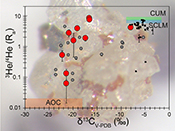 | A secretive mechanical exchange between mantle and crustal volatiles revealed by helium isotopes in 13C-depleted diamonds Abstract: Fluid inclusions trapped in fast-growing diamonds provide a unique opportunity to examine the origin of diamonds, and the conditions under which they formed. Eclogitic to websteritic diamondites from southern Africa show 13C-depletion and 15N-enrichment relative to mantle values (δ13C = -4.3 to -22.2 ‰ and δ15N = -4.9 to +23.2 ‰). In contrast the 3He/4He of the trapped fluids have a strong mantle signature, one sample has the highest value so far recorded for African diamonds (8.5 ± 0.4 Ra). We find no evidence for deep mantle He in these diamondites, or indeed in any diamonds from southern Africa. A correlation between 3He/4He ratios and 3He concentration suggests that the low 3He/4He are largely the result of ingrowth of radiogenic 4He in the trapped fluids since diamond formation. The He-C-N isotope systematics can be best described by mixing between fluid released from subducted altered oceanic crust and mantle volatiles. The high 3He/4He of low δ13C diamondites reflects the high 3He concentration in the mantle fluids relative to the slab-derived fluids. The presence of post-crystallisation 4He in the fluids means that all 3He/4He are minima, which in turn implies that the slab-derived carbon has a sedimentary organic origin. In short, although carbon and nitrogen stable isotope data show strong evidence for crustal sources for diamond-formation, helium isotopes reveal an unambiguous mantle component hidden within a strongly 13C-depleted system. |
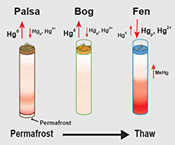 | Mercury reallocation in thawing subarctic peatlands Abstract: Warming Arctic temperatures have led to permafrost thaw that threatens to release previously sequestered mercury (Hg) back into the environment. Mobilisation of Hg in permafrost waters is of concern, as Hg methylation produced under water-saturated conditions results in the neurotoxin, methyl Hg (MeHg). Thawing permafrost may enhance Hg export, but the magnitude and mechanisms of this mobilisation within Arctic ecosystems remain poorly understood. Such uncertainty limits prognostic modelling of Hg mobilisation and impedes a comprehensive assessment of its threat to Arctic ecosystems and peoples. Here, we address this knowledge gap through an assessment of Hg dynamics across a well-studied permafrost thaw sequence at the peak of the growing season in biologically active peat overlying permafrost, quantifying total gaseous mercury (TGM) fluxes, total mercury (HgTot) in the active layer peat, porewater MeHg concentrations, and identifying microbes with the potential to methylate Hg. During the initial thaw, TGM is liberated, likely by photoreduction from permafrost where it was previously stored for decades to centuries. As thawing proceeds, TGM is largely driven by hydrologic changes as evidenced by Hg accumulation in water-logged, organic-rich peat sediments in fen sites. MeHg in porewaters increase across the thaw gradient, a pattern coincident with increases in the relative abundance of microbes possibly containing genes allowing for methylation of ionic Hg. Findings suggest that under changing climate, frozen, well-drained habitats will thaw and collapse into saturated landscapes, increasing the production of MeHg and providing a significant source of the toxic, bioaccumulative contaminant. |
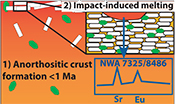 | Evidence for anorthositic crust formed on an inner solar system planetesimal Abstract: During the first million years of solar system history, planetesimals experienced extensive melting powered by the radioactive decay of 26Al (Lee et al., 1977). To date, the only known anorthositic crust on a solar system body is that of the Moon, formed by plagioclase flotation on top of the magma ocean (Wood et al., 1970). Here we show evidence from the ungrouped achondrite meteorite Northwest Africa (NWA) 8486 that an anorthositic crust formed on a planetesimal very early in solar system history (<1.7 Ma). NWA 8486 displays the highest anomalies in Eu and Sr found in achondrites so far and, for the first time, this characteristic is also identified in clinopyroxene. Elemental modelling, together with calculated timescales for crystal settling, show that only the melting of an anorthosite can produce NWA 8486 within the first 5 million years of solar system history. Our results indicate that such a differentiation scenario was achievable over short timescales within the inner solar system, and must have contributed to the making and elemental budget of the terrestrial planets. |
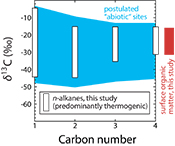 | Abiogenesis not required to explain the origin of volcanic-hydrothermal hydrocarbons Abstract: Abiotic formation of n-alkane hydrocarbons has been postulated to occur within Earth's crust. Apparent evidence was primarily based on uncommon carbon and hydrogen isotope distribution patterns that set methane and its higher chain homologues apart from biotic isotopic compositions associated with microbial production and closed system thermal degradation of organic matter. Here, we present the first global investigation of the carbon and hydrogen isotopic compositions of n-alkanes in volcanic-hydrothermal fluids hosted by basaltic, andesitic, trachytic and rhyolitic rocks. We show that the bulk isotopic compositions of these gases follow trends that are characteristic of high temperature, open system degradation of organic matter. In sediment-free systems, organic matter is supplied by surface waters (seawater, meteoric water) circulating through the reservoir rocks. Our data set strongly implies that thermal degradation of organic matter is able to satisfy isotopic criteria previously classified as being indicative of abiogenesis. Further considering the ubiquitous presence of surface waters in Earth’s crust, abiotic hydrocarbon occurrences might have been significantly overestimated. |
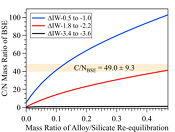 | Loss of immiscible nitrogen from metallic melt explains Earth’s missing nitrogen Abstract: Nitrogen and carbon are essential elements for life, and their relative abundances in planetary bodies are important for understanding planetary evolution and habitability. The high C/N ratio in the bulk silicate Earth (BSE) relative to chondrites has been difficult to explain through partitioning during core formation and outgassing from molten silicate. Here we propose a new model that may have released nitrogen from the metallic cores of accreting bodies during impacts with the early Earth. Experimental observations of melting in the Fe-N-C system via synchrotron X-ray radiography of samples in a Paris-Edinburgh press reveal that above the liquidus, iron-rich melt and nitrogen-rich liquid coexist at pressures up to at least 6 GPa. The combined effects of N-rich supercritical fluid lost to Earth’s atmosphere and/or space as well as N-depleted alloy equilibrating with the magma ocean on its way to the core would increase the BSE C/N ratio to match current estimates. |
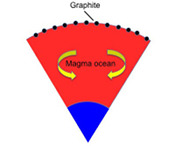 | Graphite floatation on a magma ocean and the fate of carbon during core formation Abstract: Carbon is a strongly siderophile element and current models assume that in a magma ocean, most of the carbon is sequestered into the core. Here we show that (i) for an initially highly reduced magma ocean, most of the carbon will be reduced to graphite, which is less dense than a peridotite melt; (ii) the graphite can be dynamically stable at the surface of a magma ocean; (iii) the equilibrium of the primordial atmosphere with graphite buffers CO and CO2 fugacity to such low values, that only traces of carbon dissolve in the magma ocean. Therefore, under very reducing conditions, most of the carbon may remain near the surface during core formation of a terrestrial planet and the extent of carbon sequestration into the core may be limited. We suggest that the ureilite meteorites may be the remnants of such a graphite-rich surface layer on a partially or completely molten planetesimal. A similar, graphite-enriched surface may also exist on Mercury. |
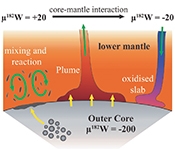 | 182W evidence for core-mantle interaction in the source of mantle plumes Abstract: Tungsten isotopes are the ideal tracers of core-mantle chemical interaction. Given that W is moderately siderophile, it preferentially partitioned into the Earth’s core during its segregation, leaving the mantle depleted in this element. In contrast, Hf is lithophile, and its short-lived radioactive isotope 182Hf decayed entirely to 182W in the mantle after metal-silicate segregation. Therefore, the 182W isotopic composition of the Earth’s mantle and its core are expected to differ by about 200 ppm. Here, we report new high precision W isotope data for mantle-derived rock samples from the Paleoarchean Pilbara Craton, and the Réunion Island and the Kerguelen Archipelago hotspots. Together with other available data, they reveal a temporal shift in the 182W isotopic composition of the mantle that is best explained by core-mantle chemical interaction. Core-mantle exchange might be facilitated by diffusive isotope exchange at the core-mantle boundary, or the exsolution of W-rich, Si-Mg-Fe oxides from the core into the mantle. Tungsten-182 isotope compositions of mantle-derived magmas are similar from 4.3 to 2.7 Ga and decrease afterwards. This change could be related to the onset of the crystallisation of the inner core or to the initiation of post-Archean deep slab subduction that more efficiently mixed the mantle. |
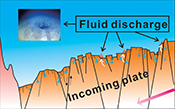 | Fluid discharge linked to bending of the incoming plate at the Mariana subduction zone Abstract: Tectonically induced bending of incoming plates at subduction zones can result in normal faulting in the upper ocean crust. Seismic surveys and numerical models indicate enhanced permeability and fluid circulation when this occurs. Yet, direct geological evidence of such effects on the seafloor is lacking. Here we report Human Occupied Vehicle (HOV) based observations of the existence of fluid discharge features on the seafloor of the incoming plate of the Mariana subduction zone. These features include fluid discharge points and associated pockmarks, which are striking, and occur in abundance in several depth related fields. The existence of Galatheid crabs, a typical seep related organism, also indicates fluid discharge from the seafloor. Alteration of the coexisting basaltic ocean crust is extensive, with iddingsite-rich muds within and overlapping the apparent fluid discharge zones. Our findings are significant in that they suggest that structural deformation of the incoming plate could substantially influence chemical exchange between the upper ocean crust and seawater in a new way. We further suggest that these fluid discharge points may represent previously unknown niches for H2-based chemolithotrophic life and microbial ecosystems at deep trenches. Observations reported here contrast both chemically and physically with serpentine mud volcano formation associated with the shallower Mariana forearc region. |
<< Previous issueNext issue >>





